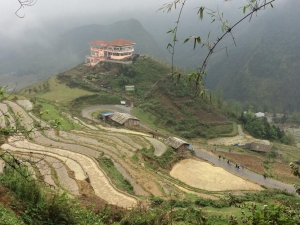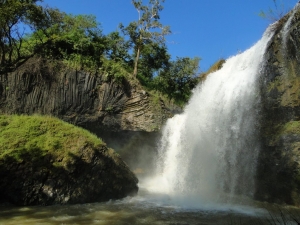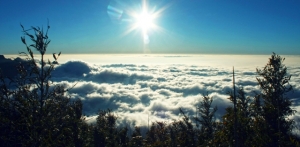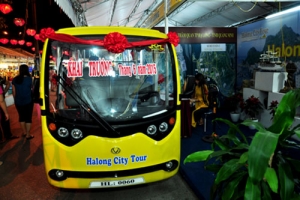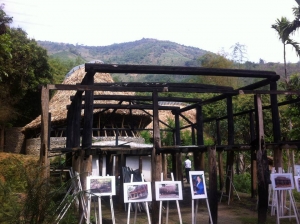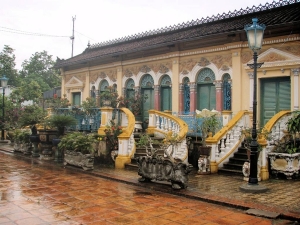
Asia Pacific Travel Team
Tourist comes to Lao Cai rise 21.7%
This figure included nearly 218,000 foreign arrivals, a 16.4% decrease against the same period last year. Total tourism revenue in the four months posted more than 1.44 trillion, a 21.8% increase over a year earlier.
In April alone, main tourist attractions in the province attracted numerous tourists, such as Sapa (138,000), Bac Ha (17,100) and Lao Cai city (80,300). In addition, the Lao Cai Information and Promotion Centre welcomed and provided service for over 12,4000 arrivals.
According to Vietnam News Agency, the 2015 Sapa Culture and Tourism week concurred with the National Reunification holiday and May Day from April 28th to May 3rd. So consequently, Sapa greeted more than 60,000 tourist arrivals, much higher than the initial expected figure of 12,000 tourists./.
Majesty White Waterfall in Quang Ngai Province
Tourists may feel lost in the beauty and majesty of nature when they arrive at Thac Trang (White Waterfall), one of the most beautiful waterfalls in the mountainous province of Quang Ngai.
The White Waterfall is located in Thanh An Commune, Minh Long District, about 30km southwest from the centre of Quang Ngai City.
The best way to reach the White Waterfall is by motorbike, said Nguyen Thanh Hung from Ha Noi.
Tourists can ride over the Eo Gio Pass on Dinh Cuong Mountain and admire the peaceful beauty of the gentle Ve River and cottages by the riverside, with amazing views of Hre ethnic villages with stilt-houses nestled on slopes, tea plantations and terraced paddies.
Climbing up to the fall upstream, Hung and his friends had to follow a rocky jungle trail with a deep abyss on one side.

The trek was worth it though when they reached the top and witnessed the amazing panorama of the mountains, forests and the waterfall.
However, tour guides are recommended because the hard trek is only for advanced climbers with the right equipment.
For casual hikers, they can choose to walk down to the foot of the waterfall and swim in the lakes or catch nien fish. The fish is a speciality of the region which can be served as sashimi or grilled and enjoyed with salt, pepper and chilli. After cleaning the fish, local people use a bamboo stick grill it on a coal fire.
On both sides of the fall, there are lots of doat trees that the Hre people use top make their special wine.
"The heat of the summer seems to vanish under the waterfall as we soak ourselves in the lake," said Hung.

The White Waterfall is well-known to local people, but not many tourists know about it, so it has remained unspoiled. As a result, tourism services are limited.
"When you plan a day trip to the White Waterfall, you should bring food, drink and a first-aid kit, especially tiger balm to stop the leeches," said Hung.
A project to build a tourist area near the White Waterfall has been started, and a bridge will be built connecting the waterfall with another wonderful natural landscape on the Dong Can Dike. The project will include a resort, a shopping centre, a park, a swimming pool, an underwater world for children, a fishing zone and a zoo.
The project will cover 57ha and will be developed from now to 2022.
Hung has returned to the White Waterfall after many years and said the route has become more accessible. "I drove to the White Waterfall by motorbike and the landscape is wonderful, while the road is less risky.
"In the future, when infrastructure is developed, it may kick off the development of local tourism, helping to push the growth of the local economy." "However, if the site receives more tourists, it will become more crowded and noisy. I hope that people will maintain the pristine beauty of the area so that tourism does not harm nature."
Discovering Bach Moc Luong Tu mountain top
It is the fourth tallest mountain in Viet Nam, trailed by Fansipan (3,143m), Pu Ta Leng (3,096m), and Pu Si Lung (3,076m). Lying between two northern provinces of Lai Chau and Lao Cai, the mountain with hasty and rocky terrain was discovered by adventurous tourists in 2012.
To climb to the top of the mountain, visitors must travel 30km of forest road and experience different types of terrain like bare hills, wood and bamboo forest and high, adventurous and sheer rock.
Visitors can conquer the Bach Moc Luong Tu’s peak from two ways: Departing from Den Sung hamlet in Sin Suoi Ho village, Phong Tho district, Lai Chau province or from Ki Quan San hamlet in Sang Ma Sao village, Bat Xat district in Lao Cai province.
Ha Long to launch electric car service for tourism in June
The Vietnam National Administration of Tourism (VNAT) cited representatives of the Ha Long City Tourism Center as saying that the service is expected to be inaugurated next month.
Ha Long City is the heart of the northern province of Quang Ninh.
The cars will carry visitors to some of the city’s major tourist attractions on two routes.
The first route, Bai Chay, is as follows: Marine Plaza -- Bai Chay Tourist Boat Wharf -- Bai Chay Tourism Complex -- Bai Chay Bridge.
The second route, Hon Gai, will depart from Vincom Ha Long and take tourists to Ha Long Market 1, Bai Tho Mountain, and the Quang Ninh Museum.
In related news, the VNAT also cited MTVT, a local travel firm, as announcing that they have just put five electric cars into operation.
The cars, worth a total of over VND750 million (US$34,952), are deployed for the Minh Chau-Quan Lan island route, the first of its kind in these island communes, which are both located in the province’s Van Don District.
These environmentally-friendly, Japanese-made cars are capable of transporting from nine to 12 passengers each, with their technical and environmental conditions having been fully inspected by competent agencies.
With the cars reaching an estimated speed of 35 kilometers per hour, the entire ride from Minh Chau Port to Quan Lan Port or the other way round takes about 45 minutes.
Fares fluctuate from VND20,000 (US$1) to VND60,000 (US$3) apiece, depending on passengers’ destinations.
MTVT plans to put another batch of 40 such cars into use in the time to come, its representatives added.
The model of electric cars has been adopted in four other places in Vietnam, namely Hanoi, Sam Son Town in north-central Thanh Hoa Province, Dong Hoi in central Quang Binh Province, and Cua Lo Town in central Nghe An Province.
According to the Ministry of Transport’s statistics released in November last year, the four localities in the northern and central regions currently boast a total of 621 electric cars, including 50 in the capital city.
Newswire Vietnamplus quoted Deputy Minister of Transport Le Dinh Tho as saying at a November 2014 meeting that the use of electric cars has boosted tourism and helped curb the number of motorbikes and cyclos – bicycle taxis that are a sort of pedicab with one or two passengers in a seat in the front and the driver pedaling in the rear – in use at scenic spots and tourist destinations.
Chien Dan Towers
Chien Dan towers represent a group of three towers and each door points to the East. Their foundations are all square in shape, wide-based with narrow steps to the top. There isn’t decoration on the body of the towers, but on the top of the towers were decorated an edging line with many masks of Kala. In Chien Dan, many sculptured artifacts with high value were discovered, especially the Yoni alter and "human animal" statues such as Naga snake, Hamsa grouse, Garuda Bird, Gajasiha elephant, etc which were influenced by Chanh Lo sculpture style (in the end of 11th century, early 12th century). The towers lie beside national highway 1, about 5km to the north of Tam Ky city.




Dong Duong Institute of Buddhism
Dong Duong Buddhism institute lies in Binh Dinh commune, Thang Binh district, about 60 km Southwest of Da Nang and about 40km Northwest of Tam Ky city.
Built in 875 under the dynasty of King Indravaman II, this was the Buddhist institute of the Champa kingdom. It was one of the most important relics of Buddhist architecture in the Champa kingdom. Due to war and time, what remains today is only a piece of a low wall, some architectural decorative pieces and the foundation of the old building.
However, scientific research documents and archaeological artifacts in Dong Duong show that it was once one of the most typical Buddhist architecture of Champa kingdom in Southeast Asia with seminaries and a Buddhist alter. The altar is in a rectangle shape 330 meters long, 240 meters wide. In 1901, the archaeologist, L. Finot found 229 relics, one of which was a bronze Buddhist statue, 1m high and influenced by Indian style-Amaravati. It’s one of the most beautiful statues in South-East Asia, now displayed in Ho Chi Minh History Museum.




Phu Ninh Lake
7 kilometres West of Tam Ky, Phu Ninh Reservoir is an irrigation works with capacity for about half of billion cubic metres of water and a surface of 3.433 hectares. This work was started in 1977 and finished ten years later. Apart from the advantages for developing irrigation, aquiculture, power-electricity, forest, agriculture and providing water for recreation....
Phu Ninh is also an ideal ecotourism area with cool air and diversified fauna all year round. There are 14 species of animal recorded in the Red Book. From this high site, tourists can view the huge reservoir with many islands covered mountains, and green forest. Tourists can take a boat around the islands enjoy the poetic and impressive beauty among the vast green forest areas. The Chap Tra valley is a mineral resource found in the middle of the quiet lake. This mineral resource is used for medical treatment such as bile, liver, and stomach diseases...
Now, Phu Ninh Reservoir is developing tourism through a variety of attractive ecotourism ideas: excursion, picnic, fishing, hot water bathe and medical treatment with hot water.




Binh Minh Beach
Binh Minh literally means the 'Sunrise '. Binh Minh Beach beach is located in the area of Binh Minh commune, about 12km to the south of Hoi An Town, Quang Nam Province. Binh Beach is over 3 km in length and up to 100m in width. The beach boasts fine white sand, clear and blue water, moderate slopes and small waves, which make it ideal for recreational activities like swimming and other sea sports.
This beach was not closest to Hoi An,but this is very beautiful and is well worth a visit to cool off when the heats starts to get to you. The only eyesore are the bizarre changing huts and bungalows. It is an incredibly long beach with loads of room to wander off for a bit of personal space, which is so difficult to find in Vietnam. If you spend a day at the beach and elect to take a deckchair, you will be asked to buy either a baguette, some lovely pineapple or a drink, otherwise you will have to pay for the seat. All these prices are inflated, but the pineapple in particular is delicious.
After visiting the relics in the old town, visitors can go to Binh Minh to enjoy sea food specialities in an ideal environment of immense sky and sunshine, also can stop at some fishing villages near by Binh Minh beach. The Cham island lying on the horizon also comes in view in clear weather
The fine sands of palm-lined Binh Minh Beach (bai tam Binh Minh) are popular at weekends, but can often be deserted at other times. Safe swimming is usually only possible between March and October, but it's nice to walk or just hang out here. This is a monster beach that continues all the way up to Tam Ky city, an incredible 30km of pristine white sands. Fresh seafood and refreshments are sold at a line of kiosks that lead to the beachfront.



Muong ethnic culture museum opened in Hoa Binh
The complex includes six buildings spanning 4,000 square metres, serving the study, collection, preservation and showcasing of the cultural legacy of the Muong ethnic group.
It also offers other Muong culture-related services, such as cuisine, art performances and traditions.
Some 5,000 items have been put on display at the museum, including a thousand-year-old bronze drum, gongs and pottery.
The facility is the second private museum in the locality and the 24th in Viet Nam.
The Muong is the fourth largest of Viet Nam’s 54 ethnic group with an estimated population of 1.3 million.
The Muong people inhabit the northern mountainous region, mainly in Hoa Binh and some mountainous districts of northern central Thanh Hoa province.
Long Tuyen ancient village in Mekong Delta
Long Tuyen (also called Binh Thuy), one of the country's five top ancient villages, is a must-see destination in the Cuu Long (Mekong) Delta city of Can Tho as the 170 year-old village in Binh Thuy District has beautiful natural scenery and cultural relics.
About 5km away from Can Tho's centre, Long Tuyen is located along the peaceful and poetic Binh Thuy River. Locals build their houses and fruit orchards along the river banks, creating picturesque scenery with fresh air and quiet settings.
Binh Thuy Temple, Nam Nha and Hoi Linh pagodas, patriot Bui Huu Nghia's Tomb, the Communist Party of An Nam's office and nha co vuon lan (ancient house with orchid garden) are the village's national heritage sites. — VNS


